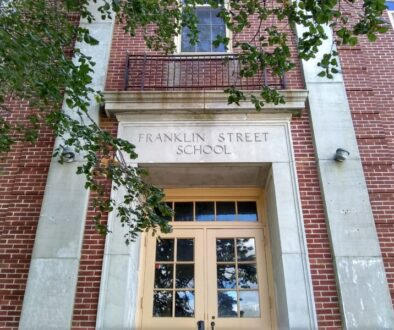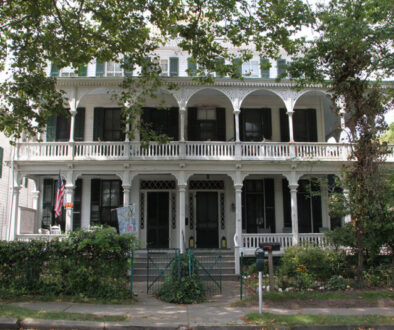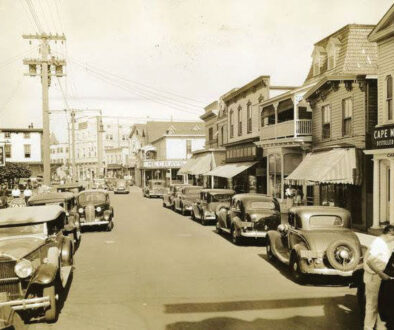Wheel’s Up: Getting to know Cape May’s special brand of bike magic
“They rode on in silence, gradually leaving the countryside behind them, along with the mingled smell of hay and honeysuckle, which would soon be replaced by the scent of salty air mixed with coconut oil.”
It All Started with a Bicycle
In this passage from It All Started With a Bicycle, 11-year-old protagonist Pam Fischer pedals a surrey through the distinctive landscape changes that characterize Cape May. “More than any particular landmark, there are features to Cape May that make it inherently unique,” explains the 2011 youth novel’s author Jocelynn Cordes, who writes under the name Plum McCauley. “West Cape May, for instance, is farm country. But it’s barely two miles from the beach and all that that entails. So when my adventure-seeking cohort rides into West Cape May, the very scent of the air is redolent of fields and farmland.”
The setting for the story was never a question for Cordes. “I had many different summer jobs in Cape May, including one in a bed-and-breakfast,” she recounts. “And those experiences form a substantial part of the backdrop against which my adventure story plays out, from Victorian architecture, which plays a crucial role, to omnipresent beach tag inspectors, from fudge shops to the very streets on which a bicycle chase takes place.”
Indeed, Cape May is a haven for cycling of all kinds, whether pedaling a cruiser down Beach Avenue for ice cream, rolling out at daybreak to squeeze in some miles before the rest of the family wakes up, or relaxing alongside friends new and old on Thursday evening’s Cape May Hustle.
Cruising Around
“We have 80 percent repeat clientele over the summer, and more than half of them bring their bicycles with them,” says John Cooke, who manages the Victorian Motel in the center of town. “Because of where we’re located, and that parking is included when they stay, they will park their cars and say they no longer need them, because they’re going to ride their bikes everywhere.”
Popular destinations include the lighthouse, Beach Plum Farm, Willow Creek Winery, and of course, downtown Cape May. In addition, bicycles are permitted on the boardwalk until 10am.

No bike? No problem.
“Rent a bike—parking’s a breeze,” waxes Tom Roth, owner of Cape Island Bikes, which offers hourly, daily, and weekly rentals at four different locations throughout town. “When you rent a bike, you’ve got easy transportation throughout the area.”
Roth was always a “bike kid,” according to his mother. “She says I was born with a wrench in my hand.” So he grew up and became a bike guy, working in the industry for 35 years and racing bikes. But something always kept nagging at him, an image from when he used to help out at a local real estate office on check-in day. “People would come in to pick up the keys to their rentals, and the next thing they’d ask is, ‘Where is the bike rental?’”
In 1997, he jumped on the opportunity, starting with a delivery service for rental bikes which then grew into a brick and mortar location on Howard Street in the Hotel Macomber a year later. That first store quickly expanded to the four locations that exist today.
The signature sunshine yellow cruiser bikes in Cape Island Bikes’ rental fleet have an impressive pedigree. Created to withstand the rigors of rental life at the beach, the design was inspired by Roth’s experience at Cape Island Bikes and brought to life during his tenure as Vice President of Sales for Fuji Bicycles. The bikes offer an aluminum frame, alloy wheels, and a rust-resistant chain. “A lot of people assume rental bikes are cheap, ninety-dollar Huffys,” he relates. “But they’re not, because those would never hold up as rentals.”
When it came time to name the cruiser, the choice was obvious: the “Cape May,” of course. To this day, the Fuji Cape May is a gold standard of beach cruiser, used by rental companies and sold to consumers at stores all across the country, including Cape Island Bikes at Congress Hall.
There is more to Cape May cycling than just beach cruisers, however.
Putting the Hammer Down
For avid cyclists, one of the greatest pleasures is letting it rip on the flat, deliciously fast ribbons of tarmac often found in coastal areas. But finding the perfect route—one uninterrupted by traffic lights, crowds, and distracted drivers—can prove elusive.
Todd deSatnick, a real estate broker in town, has been perfecting routes on his road bike for the last 12 years. When he finds himself pressed for time, he opts for laps around the perimeter of Cape May City. “I’ll throw Sunset Boulevard and the Point into the mix, too. My standard is 30 miles without going over the bridge,” he says. His current favorite stretch, though, is Ferry Road from the bay to Cape May. “The newer asphalt and the grade, combined with a southwest wind, are an ideal setup for fast speeds.”
Tom Roth’s go-to loop is 11 miles around the island traversing both bridges. “Go out Broadway and take Bayshore to New England Road, and then Jonathan Hoffman Road out to the bay,” he says. When he wants more miles, he can simply add more loops, or head over to the bike path location that runs parallel to Seashore Road, options that allow him to boost his mileage upwards of 45 miles, most of them car-free.
One of Craig Fitz’s favorite rides is over to Sunset Beach via the Willow Creek Winery and Beach Plum Farm. Fitz, a Cape May cyclist since 1988, explains, “I’ll come back via Cape May Point, Lake Lily, the lighthouse, Hawk Watch, and Cove Beach. If I want to extend that ride, I’ll go to Higbee Beach and past the alpaca farm, too.”
For anyone looking to rack up serious miles, Fitz also suggests heading out of Cape May to all the points along Ocean Drive, including Wildwood Crest, Wildwood, North Wildwood, Hereford Lighthouse, Stone Harbor, Avalon, Sea Isle, and Strathmere.
Not everything is about speed, though.
Cooling it Down
On Thursday evenings at 5:30, an eclectic crew assembles in the parking lot of Sunset Liquors in West Cape May. Lanky racer types in skinny jeans lean against their top tubes, parents hitch up trailers filled with kids and coolers, and people in baggy shorts on beach cruisers zip up their backpacks. This is the Cape May Hustle, a year-round weekly rolling party that celebrates community and the magic of the bicycle.
Now entering its third year, the Hustle grew out of an informal race series. “There was nowhere to do that, really,” explains Hustle founding member Peter Hardy. “So we started going out to the Point in the off season, picking out quiet streets, and having these 15 to 20 minute races.” They would station volunteers at corners to keep an eye out for traffic so that competitors could zip around the course at full tilt.
While the races were fun, more people ended up standing at intersections with signs than participating in the race itself. “Only a few of us were dedicated to racing,” he recalls. “After a year, we thought to ourselves, ‘How can we branch out and reach more people?’” Enter the Hustle—captured in a thirty-minute YouTube video created by another Hustle founding member, Matt Ciancaglini—in which vibrant, laughing people glide along with their hair blowing in the golden hour of the evening.
“There are some serious riders in the group,” notes Village Bicycle Shop’s Mark Jacopec. “Fixies (one-speed, fixed-gear bikes where the rear wheel doesn’t “freewheel,” or coast) are mostly our bike of choice, but almost everyone in the core group has a bike for every occasion. In the winter, it’s mostly the core group of riders, but regardless of the weather, it happens every week.”
Inclusion is the overarching theme. “The bike is the common glue that binds us,” says Hardy. “We wanted a pace where everyone felt comfortable. People in their seventies come out and ride. We plotted a uniform route that doesn’t change, so if you’re running late from work, you can cut out half the ride and meet up with us.”
The Hustle may be the most visible social ride in town, but it certainly isn’t the only one. Informal groups organize rides based around connecting local eating and drinking establishments. Craig Fitz and a group of friends regularly embark on “brewery rides.” “There are now over six breweries within 25 miles of Cape May, with more coming on line in 2018,” he notes. “Just between Cape May and Cape May Court House, there are at least four breweries, and many good places to eat.” At about 25 miles round trip, these four breweries are only a short distance from the bike trail, too.
Proper hydration—and moderation—are key. “If you take your time, have lunch, and drink in moderation,” he cautions, “you can make a fun and safe day visiting several of these breweries.”
Keeping the Momentum
It’s a Wednesday afternoon in the middle of August, and the multiuse path that connects Historic Cold Spring Village to the Cape May County Zoo is delightfully quiet. Groves of trees on either side of the trail dapple sunlight onto the pavement. The trail seems a world away from the bustle of a busy beach town in high season, and yet it is just a few short miles beyond it.
Cape May has always touted its bike friendliness, and worked to expand offerings for cyclists of all kinds. Even as far back as June 27, 1897, The New York Times lauded the brand new bicycle paths that would greet visitors that season.
The Bicycle and Pedestrian Advisory Committee (BAPAC) is tasked with improving safety and access. It is a mix of people, including business owners, cyclists, walkers, and runners.
They’ve got big plans.
“Making our streets and bike paths safe and easy to negotiate is our commitment,” explains BAPAC member Hilary Pritchard. Some of the committee’s agenda items include reviewing signage for accuracy and relevance, determining which existing bike paths need better definition or new paint, and working with a grant to improve conditions for school children riding bikes to school. “We are also partnering with Fund for Cape May on improvements to the War Memorial monument on Gurney and Columbia Streets,” she continues. “Plans are to increase the size and improve accessibility to the area, which will, in turn, resolve confusion that currently exists for pedestrian, bicycle, and auto traffic.”
One significant undertaking is a change to the speed limit on Pittsburgh Avenue. “We presented a recommendation to the city that they ask the county to lower the speed limit from 35 to 25 miles per hour,” says Peter Hardy, who is also on the committee. “Out of 12 crosswalks, only one is currently marked, and the bike lanes are uniformly fading and poorly marked.”
As a Coast Guard family (Hardy is prior service, and his wife is active duty), Hardy knows firsthand about how intimidating that area can be. “Pittsburgh Avenue is the only way in and out of town for Coast Guard families. You feel like you’re a fish out of water when you’re transferring here in June and July. People get nervous about the heavy traffic flow.”
Another major initiative is the creation of an official bike route around the island. “We’re trying to branch out to all four municipalities, Lower, Cape May Point, West Cape May, and Cape May City,” he said. “For the first time in the five years I’ve lived here, all the leaders are on board with this.”
The plan is a process. In September of 2014, traffic pattern changes were debuted at the Cape May Ferry Terminal, creating a dedicated path for pedestrians and bicyclists from Lincoln Boulevard into and out of the Terminal, and a new exit for vehicles from the terminal onto Beach Drive. “The new traffic pattern was designed to enhance safety and promote bicycling in the Twin Capes region,” proclaims a March 24, 2015 news release from the Delaware Department of Transportation. And just this past year, Lower Township cut the ribbon on a long-awaited connector path that allows cyclists to ride all the way from the ferry terminal to Cape May County Park and Zoo.
The changes all focus on helping residents and visitors become less dependent on their cars. “Look, we’ve lost our battle with the parking infrastructure,” explains Hardy. “That comes out as harsh, but if we can encourage visitors to the island to leave their cars at the places they stay, they can ride their bikes everywhere. To encourage that, there need to be routes that are safe for people to ride with their children who have various skill levels.”
Hilary Pritchard concurs. “I am really fired up about having this actually happen with a beautiful master plan, and making Cape Island a world-class bicycling destination. The bicycle paths have always been a bit of a mish-mash, with paths that really don’t lead anywhere. We see families here bicycling and that’s what you want, to allow families to have that experience that they would not have in the cities or suburban neighborhoods where they are from. I want people to see the natural beauty of this place.”
“For the first time in many, many months, Pam experienced the exhilaration of riding again. As soon as her tires hit paved road, she leaned into the pedals with a vengeance. She kept on riding furiously, and didn’t slow down until her leg muscles shook and a sharp pain shot through each thigh.”
When the young heroine in Jocelynn Cordes’ tale finally climbs on a bike again, she revels in the glory. “It was an important summer experience she has been deprived of because her bike was stolen the previous winter,” Cordes reflects. “When I lived in Cape May, people rode bikes everywhere, even out to dinner. And not racing bikes—plain old no-speed bikes that were dented and chewed up through time, use, and the weather.”
The appeal of bicycles is universal, and the implications are powerful. “If you were to wave a magic wand and restrict the traffic away from the downtown, I think bicycling would become the primary mode of transportation,” muses John Cooke. “It would alleviate traffic backups that happen during the season, and you’d see everyone getting around on bikes.”
It is an idea both timeless and modern, like Cape May itself.



